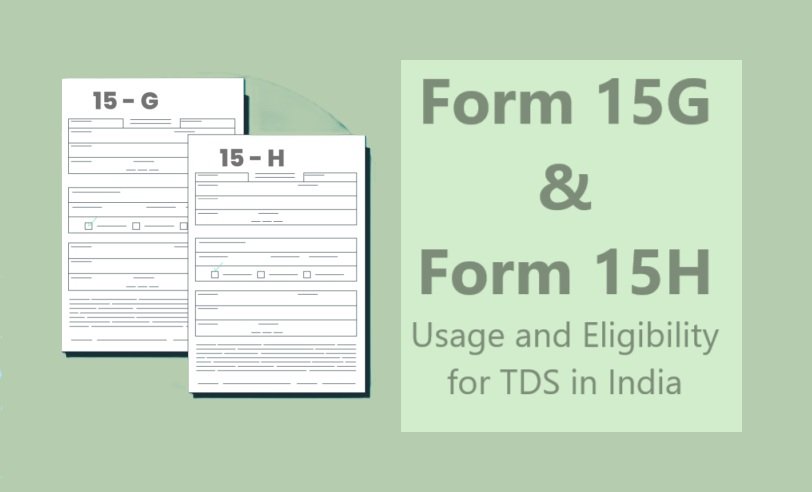
Tax Deducted at Source (TDS) is a mechanism by which the government collects tax at the source of income. While this ensures regular tax collection, it may lead to excess tax deductions, particularly for individuals with incomes below the taxable threshold. Forms 15G and 15H serve as declarations to prevent unnecessary TDS deductions for eligible individuals. This guide explores their usage, eligibility criteria, and how they function within India’s tax framework.
What Are Form 15G and Form 15H?
Form 15G
Form 15G is a self-declaration form submitted by individuals below 60 years of age to request that TDS not be deducted on their income. This form is primarily used when the individual’s total income is below the taxable limit.
Form 15H
Form 15H is similar to Form 15G but is specifically designed for senior citizens (individuals aged 60 years and above). It allows them to avoid TDS deductions on eligible incomes if their total income is below the taxable limit.
Form 15G Eligibility Criteria
- Age Limit: The individual must be below 60 years.
- Residency: Only Indian residents are eligible.
- Income Limit: The total income (including interest) must not exceed the basic exemption limit (₹2,50,000 as of the current tax slabs).
- Tax Liability: There should be no tax liability on the individual’s total income for the financial year.
Form 15H Form 15H Eligibility Criteria
- Age Limit: The individual must be 60 years or above.
- Residency: Only Indian residents can apply.
- Income Limit: The total income, including interest, must be below the taxable threshold for senior citizens (₹3,00,000 or ₹5,00,000 depending on the tax slab).
- Tax Liability: The individual’s estimated tax liability must be nil for the financial year.
Common Uses of Form 15G and Form 15H
- Interest on Fixed Deposits (FDs): Banks and financial institutions deduct TDS on interest earned above ₹40,000 (₹50,000 for senior citizens) per annum. Submitting these forms prevents TDS deductions if eligible.
- Income from Post Office Deposits: Interest from post office schemes may attract TDS if above the threshold.
- EPF Withdrawals: If the Provident Fund withdrawal is before five years of continuous service, TDS is applicable. Forms 15G or 15H can prevent this deduction for eligible individuals.
- Income from Corporate Bonds: TDS on interest income from bonds can be avoided using these forms.
- Insurance Policy Payouts: TDS applies to certain taxable insurance payouts, and these forms can help avoid deductions if the criteria are met.
Filing Process
- Obtain the Form: Forms 15G and 15H can be downloaded from the websites of banks, the Income Tax Department, or obtained from bank branches.
- Fill in the Details:
- Personal information such as name, PAN, and address.
- Details of income for which TDS is to be avoided.
- Declaration confirming eligibility.
- Submit to the Institution: Submit the completed form to the institution deducting TDS (e.g., bank, EPF office).
- Submission Timeline: Ideally, these forms should be submitted at the beginning of the financial year to avoid any deductions.
Key Points to Remember
- PAN Requirement: Providing a valid PAN is mandatory; otherwise, TDS will be deducted at a higher rate.
- Separate Submission: These forms must be submitted to each institution where TDS applies.
- Renewal Each Year: Form 15G or 15H must be filed annually to remain valid for that financial year.
- Accurate Estimation: Ensure that your total income estimation is accurate to avoid penalties for false declarations.
Penalties for Misuse
Providing false information in Form 15G or Form 15H is a serious offense under the Income Tax Act. Penalties can include fines or prosecution if the declarations are found to be incorrect.
Differences Between Form 15G and Form 15H | Form 15G vs Form 15H
| Aspect | Form 15G | Form 15H |
|---|---|---|
| Age Eligibility | Below 60 years | 60 years and above |
| Income Threshold | Basic exemption limit (₹2,50,000) | Senior citizen limits (₹3,00,000 or ₹5,00,000) |
| Residency Requirement | Indian residents only | Indian residents only |
Read This: DigiSaathi Portal: Empowering India’s Digital Payment Ecosystem
Conclusion
Forms 15G and 15H are invaluable tools for individuals whose incomes fall below the taxable threshold, allowing them to manage their cash flows effectively by avoiding unnecessary TDS deductions. However, proper understanding and responsible usage of these forms are critical to ensure compliance with tax laws and to avoid penalties. Always consult a tax advisor if in doubt about eligibility or filing requirements.






